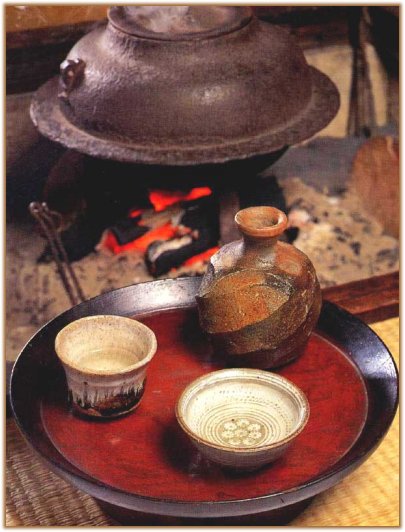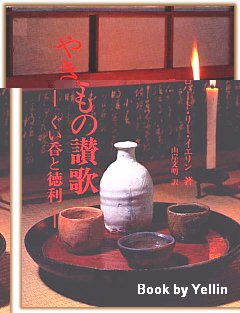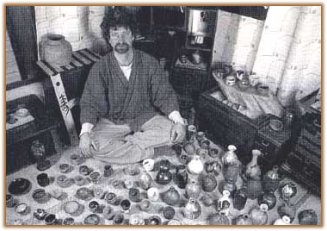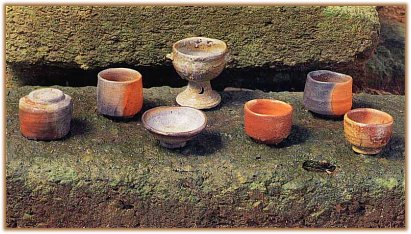|
Hand-made Objects
Have Soul of Their Own
By ROBERT YELLIN
for the Japan Times, September 17, 2003

I've often been asked about my beginnings with Japanese pottery and how I got so deeply interested in the subject. Mostly, it was a philosophical and intuitive introduction that just struck a chord within me, as well as topics associated with Zen and the present. As with most inspiring art, words often interfere, and logic usually fails to help one "get it."
 In order to give you an insight into how I see it, I'd like to share some excerpts from my book "Yakimono Sanka (Ode to Pottery, Sake Cups and Flasks)," published in 1995 by Kogei Shuppan (see book cover at right). The book is only available in Japanese as of this writing. I hope to have it out in English next year. In order to give you an insight into how I see it, I'd like to share some excerpts from my book "Yakimono Sanka (Ode to Pottery, Sake Cups and Flasks)," published in 1995 by Kogei Shuppan (see book cover at right). The book is only available in Japanese as of this writing. I hope to have it out in English next year.
BEGIN EXCERPT:
Living with Japanese pottery has opened my eyes to a world of beauty and thought. It has guided my senses and spirit to an understanding of daily living as an opportunity to experience the divine in the routine motions of life. Using Japanese pottery has allowed me to appreciate everyday crafts that, when properly arranged and balanced, enter into the realm of art and into one's life and personality. It has been this way for centuries in Japan and continues into the present.
There are forms of pottery in Japan that have changed little for hundreds of years. Yet there are potters living today who do not make mere academic copies of the ancient masterpieces. They infuse into the flowing tradition an expression of the present age. These are the potters whose pieces I have sought, potters who carry on a dialogue with the masters of centuries past. In this way pottery of eternal beauty is born. And these pieces I can bring into my daily existence, using them in the everyday rituals of life -- eating and drinking. Through the use and appreciation of such pieces, a simple and profound beauty has seeped into my soul.
This is the wisdom beyond the cult of tea and the Japanese culture of food. Unfortunately, many Japanese have forgotten their own culture and surround their life with machine-made objects. Objects made not from the soul of humanity, but from the business of the mind. Objects made not for the purpose of uplifting the spirit, but for the sole purpose of monetary profit. The founder of the Japan Crafts Movement, Yanagi Soetsu, wrote in his classic book The Unknown Craftsmen:
On reflection, one must conclude that in bringing cheap and useful goods to the average household, industrialism has been of service to mankind -- but at the cost of the heart, of warmth, friendliness and beauty." To which I would like to add "and at the expense of nature and the precious resources of this glorious yet fragile home we all share, Earth.
If we use objects in our daily life that move the heart and help us transcend our daily routines and ways of thinking, we may be able to lift our spirits to a plane that will incorporate caring for the earth as part of existence. And nothing seems to be more appropriate than using pottery, which brings together clay, air, fire and water -- the elements that create and give us life.
In Japan, the styles, glazes, shapes and price ranges of pottery can boggle the mind. Trying to collect them all would be somewhat foolish. Following the advice of Hugh Munsterberg in The Ceramic Art of Japan: A Handbook for Collectors, I have decided to focus my collection on sake cups and bottles.

Another factor in my decision was the limited space available in a typical Japanese home. The cups and bottles represented in this book can fit into a small room, and each has its own unique character. Like we humans, each piece is one of a kind. So my collection room is a room full of "people" getting ready to go to a party or for a weeklong session of Zen meditation. This collection speaks to me in the silence of a wise and ancient truth -- a connection with the ever-flowing river of humanity. For in a cup, all time comes together -- past, present, and future -- and all lose themselves inside! The works have become my teachers, instructing me about the history of Japan, Zen, the cult of tea, the elusive aesthetic concepts of wabi-sabi, and the beauty of Japanese food. I think it was the wandering Zen monk Santoka Taneda, a great lover of sake, who said, "Truth is seeing the new in the ordinary" and that "there are hidden treasures in the present moment." Using these pieces every day puts me in position to see the magic in the present moment. The pieces I have collected over the years have nothing to do with beauty or ugliness. I'm more interested in their "thusness," a quality that can speak to my heart and thus, without trying, lift my consciousness to a realm where I can talk with the ancient masters myself.

Various Bizen Guinomi (sake drinking cups)
I much prefer giving the money I earn from my labor to a ceramic artist than to a large, shapeless, multinational corporation that goes around exploiting the environment for the sake of profit and prestige. When I support a potter, I am also helping to preserve a craft that goes beyond the fad or trend of the year and, through its heritage, transcends the age in which we live. What goods can a large corporation manufacture that will make worthy heirlooms? The pieces that are in this book will pass through my hands and into those of my children or some other person whose level of appreciation is similar to mine. No matter what era the pieces flow into, they will still speak to the heart of man and not to his mind. These pieces speak of a truth beyond knowledge. Most of the mass-produced products companies spew out each year become obsolete the next. Most speak of nothing but the greed of the mind. For this reason, I give my support to the creators of beauty in a clay cup.
The Japan Times: Sept. 17, 2003
(C) All rights reserved
|